Dual-Element Wideband CP Slot-Integrated MIMO Antenna with X-Notch Square AMC for DSRC Applications
Abstract
1. Introduction
2. Antenna Design
2.1. The Proposed Dual-Element Wideband CP Slot-Integrated MIMO Antenna with X-Notch Sqaure AMC
2.2. Antenna Evolution Process
3. Experimental Results and Discussion
4. Conclusions
Author Contributions
Funding
Institutional Review Board Statement
Informed Consent Statement
Data Availability Statement
Conflicts of Interest
References
- Zhou, H.; Xu, W.; Chen, J.; Wang, W. Evolutionary V2X Technologies Toward the Internet of Vehicles: Challenges and Opportunities. Proc. IEEE 2020, 108, 308–323. [Google Scholar] [CrossRef]
- Saad, M.M.; Khan, M.T.R.; Shah, S.H.A.; Kim, D. Advancements in Vehicular Communication Technologies: C-V2X and NR-V2X Comparison. IEEE Commun. Mag. 2021, 59, 107–113. [Google Scholar] [CrossRef]
- Molina-Masegosa, R.; Gozalvez, J. LTE-V for Sidelink 5G V2X Vehicular Communications: A New 5G Technology for Short-Range Vehicle-to-Everything Communications. IEEE Veh. Technol. Mag. 2017, 12, 30–39. [Google Scholar] [CrossRef]
- Abou-Zeid, H.; Pervez, F.; Adinoyi, A.; Aljlayl, M.; Yanikomeroglu, H. Cellular V2X Transmission for Connected and Autonomous Vehicles Standardization, Applications, and Enabling Technologies. IEEE Consum. Electron. Mag. 2019, 8, 91–98. [Google Scholar] [CrossRef]
- Guo, H.; Wymeersch, H.; Makki, B.; Chen, H.; Wu, Y.; Durisi, G.; Keskin, M.F.; Moghaddam, M.H.; Madapatha, C.; Yu, H.; et al. Integrated Communication, Localization, and Sensing in 6G D-MIMO Networks. IEEE Wirel. Commun. 2025, 32, 214–221. [Google Scholar] [CrossRef]
- Jeon, J.; Lee, G.; Ibrahim, A.A.; Yuan, J.; Xu, G.; Cho, J.; Onggosanusi, E.; Kim, Y.; Lee, J.; Zhang, J.C. MIMO Evolution toward 6G: Modular Massive MIMO in Low-Frequency Bands. IEEE Commun. Mag. 2021, 59, 52–58. [Google Scholar] [CrossRef]
- Shlezinger, N.; Ma, M.; Lavi, O.; Nguyen, N.T.; Eldar, Y.C.; Juntti, M. Artificial Intelligence-Empowered Hybrid Multiple-input/multiple-output Beamforming: Learning to Optimize for High-Throughput Scalable MIMO. IEEE Veh. Technol. Mag. 2024, 19, 58–67. [Google Scholar] [CrossRef]
- Rodríguez-Corbo, F.A.; Celaya-Echarri, M.; Shubair, R.M.; Falcone, F.; Azpilicueta, L. Spatial MIMO Channel Characterization Under Different Vehicular Distributions. IEEE Antennas Wirel. Propag. Lett. 2024, 23, 3163–3167. [Google Scholar] [CrossRef]
- SRoger, S.; Martin-Sacristan, D.; Garcia-Roger, D.; Monserrat, J.F.; Kousaridas, A.; Spapis, P.; Ayaz, S. 5G V2V Communication With Antenna Selection Based on Context Awareness: Signaling and Performance Study. IEEE Trans. Intell. Transp. Syst. 2022, 23, 1044–1057. [Google Scholar] [CrossRef]
- Ullah, S.; He, Y.; Huang, Y. A Triband Circular-Polarized Four-Port MIMO Antenna With Compact Size and Low Mutual Coupling. IEEE Antennas Wirel. Propag. Lett. 2025, 24, 621–625. [Google Scholar] [CrossRef]
- Sufian, A.; Hussain, N.; Abbas, A.; Lee, J.; Park, S.G.; Kim, N. Mutual Coupling Reduction of a Circularly Polarized MIMO Antenna Using Parasitic Elements and DGS for V2X Communications. IEEE Access 2022, 10, 56388–56400. [Google Scholar] [CrossRef]
- Sahu, N.K.; Das, G.; Gangwar, R.K.; Rambabu, K. An Arrangement for Four-Element MIMO DRA With Complementary CP Diversity. IEEE Antennas Wirel. Propag. Lett. 2021, 20, 1616–1620. [Google Scholar] [CrossRef]
- Saxena, S.; Kanaujia, B.K.; Dwari, S.; Kumar, S.; Choi, H.C.; Kim, K.W. Planar Four-Port Dual Circularly-Polarized MIMO Antenna for Sub-6 GHz Band. IEEE Access 2020, 8, 90779–90791. [Google Scholar] [CrossRef]
- Ullah, U.; Ben Mabrouk, I.; Koziel, S.; Al-Hasan, M. Implementation of Spatial/Polarization Diversity for Improved-Performance Circularly Polarized Multiple-Input-Multiple-Output Ultra-Wideband Antenna. IEEE Access 2020, 8, 64112–64119. [Google Scholar] [CrossRef]
- Kumar, S.; Nandan, D.; Srivastava, K.; Kumar, S.; Singh, H.; Marey, M.; Mostafa, H.; Kanaujia, B.K. Wideband Circularly Polarized Textile MIMO Antenna for Wearable Applications. IEEE Access 2021, 9, 108601–108613. [Google Scholar] [CrossRef]
- Kollipara, V.; Peddakrishna, S. Quad-Port Circularly Polarized MIMO Antenna with Wide Axial Ratio. Sensors 2022, 22, 7972. [Google Scholar] [CrossRef]
- Soliman, S.A.M.; Eldesouki, E.M.; El-Nady, S.M.; El-Hameed, A.S.A. Broadband Low RCS Based on Polarization- Dependent Artificial Magnetic Conductor Metasurface. IEEE Access 2023, 11, 53176–53184. [Google Scholar] [CrossRef]
- Ameen, M.; Chaudhary, R. Metamaterial Circularly Polarized Antennas: Integrating an epsilon negative transmission line and single split ring-type resonator. IEEE Antennas Propag. Mag. 2021, 63, 60–77. [Google Scholar] [CrossRef]
- Ardekani, M.H.M.; Pashangeh, S. A Novel Method to Design Small Wideband Half Mode Cavity Antenna Under Resonances of TM1,1 and TM3,1 Modes. IEEE Access 2024, 12, 127629–127636. [Google Scholar] [CrossRef]
- Chaouche, Y.B.; Nedil, M.; Ben Mabrouk, I.; Ramahi, O.M. A Wearable Circularly Polarized Antenna Backed by AMC Reflector for WBAN Communications. IEEE Access 2022, 10, 12838–12852. [Google Scholar] [CrossRef]
- Askari, H.; Hussain, N.; Choi, D.; Sufian, A.; Abbas, A.; Kim, N. An AMC-Based Circularly Polarized Antenna for 5G sub-6 GHz Communications. Comput. Mater. Contin. 2021, 69, 2997–3013. [Google Scholar] [CrossRef]
- Han, L.; Chai, K.; Han, G.; Chen, X.; Zhang, W. Compact Broadband Circularly Polarized Slot Antenna with Artificial Magnetic Conductor Reflector. Int. J. RF Microw. Comput.-Aided Eng. 2022, 32, e23534. [Google Scholar] [CrossRef]
- Kumari, P.; Das, S. A Wideband Circularly Polarized SIW MIMO Antenna Based on Coupled QMSIW and EMSIW Resonators for Sub-6 GHz 5G Applications. IEEE Antennas Wirel. Propag. Lett. 2024, 23, 2979–2983. [Google Scholar] [CrossRef]
- Doan, T.N.H.; Nguyen, K.K.; Ta, S.X. Dual-Band Dual-LP/CP Antennas Using Combined Metasurface and Patch For UHF/2.45-GHz RFID Readers. IEEE Access 2024, 12, 78833–78842. [Google Scholar] [CrossRef]
- Chen, S.; Liu, X.; Jing, X.; Cui, Y. A Wideband Quad-Port 3-D MIMO Antenna Decoupled with DGS Structure for Roadside Units. IEEE Antennas Wirel. Propag. Lett. 2025, 24, 616–620. [Google Scholar] [CrossRef]
- Supreeyatitikul, N.; Janpangngern, P.; Lertwiriyaprapa, T.; Krairiksh, M.; Phongcharoenpanich, C. CMA-Based Quadruple-Cluster Leaf-Shaped Metasurface-Based Wideband Circularly-Polarized Stacked-Patch Antenna Array for Sub-6 GHz 5G Applications. IEEE Access 2023, 11, 14511–14523. [Google Scholar] [CrossRef]
- Supreeyatitikul, N.; Lertwiriyaprapa, T.; Chudpooti, N.; Krairiksh, M.; Phongcharoenpanich, C. Broadband Multi-Shaped Metasurface Circularly Polarized Antenna with Suppressed Non-CP Radiation Modes. IEEE Open J. Antennas Propag. 2023, 4, 900–911. [Google Scholar] [CrossRef]
- Kamonsin, W.; Krachodnok, P.; Chomtong, P.; Akkaraekthalin, P. Dual-Band Metamaterial Based on Jerusalem Cross Structure with Interdigital Technique for LTE and WLAN Systems. IEEE Access 2020, 8, 21565–21572. [Google Scholar] [CrossRef]
- Dai, Z.F.; Pan, Y.; Huang, J.J.; Ye, L.H.; Li, J.-F.; Jiang, H. Low-Profile Broadband Dual-Polarized Dipole Antenna with AMC Reflector. IEEE Antennas Wirel. Propag. Lett. 2024, 23, 3496–3500. [Google Scholar] [CrossRef]
- Raad, H.R.; Abbosh, A.I.; Al-Rizzo, H.M.; Rucker, D.G. Flexible and Compact AMC Based Antenna for Telemedicine Applications. IEEE Trans. Antennas Propag. 2013, 61, 524–531. [Google Scholar] [CrossRef]
- Ashyap, A.; Raad, R.; Tubbal, F.; Khan, W.A.; Abulgasem, S. Comprehensive Review of Wearable Antennas with Flexible Periodic Structures for Body-Effect Mitigation. IEEE Access 2025, 13, 22590–22636. [Google Scholar] [CrossRef]
- Rahmat-Samii, Y. Electromagnetic Band Gap Structures in Antenna Engineering; Cambridge University Press: Cambridge, UK, 2009. [Google Scholar]
- Arulmurugan, S.; Kumar, T.R.S.; Sidén, J.; Alex, Z.C. Circular Polarized Dual-Band Wearable Screen-Printed MIMO Antenna Integrated with AMC for WBAN Communications. IEEE Open J. Antennas Propag. 2024, 5, 1805–1814. [Google Scholar] [CrossRef]
- Elahi, M.; Koziel, S.; Leifsson, L. Self-Isolation in MIMO Array Using Mode Diversity. IEEE Access 2025, 13, 45023–45036. [Google Scholar] [CrossRef]
- Wang, Z.; Li, C.; Yin, Y. A Meta-Surface Antenna Array Decoupling (MAAD) Design to Improve the Isolation Performance in a MIMO System. IEEE Access 2020, 8, 61797–61805. [Google Scholar] [CrossRef]
- Zeain, M.Y.; Abu, M.; Althuwayb, A.A.; Alsariera, H.; Al-Gburi, A.J.A.; Abdulbari, A.A.; Zakaria, Z. A New Technique of FSS-Based Novel Chair-Shaped Compact MIMO Antenna to Enhance the Gain for Sub-6GHz 5G Applications. IEEE Access 2024, 12, 49489–49507. [Google Scholar] [CrossRef]
- Ullah, U.; Al-Hasan, M.; Koziel, S.; Ben Mabrouk, I. Circular Polarization Diversity Implementation for Correlation Reduction in Wideband Low-Cost Multiple-Input-Multiple-Output Antenna. IEEE Access 2020, 8, 95585–95593. [Google Scholar] [CrossRef]
- Ullah, U.; Ben Mabrouk, I.; Koziel, S. Enhanced-Performance Circularly Polarized MIMO Antenna with Polarization/Pattern Diversity. IEEE Access 2020, 8, 11887–11895. [Google Scholar] [CrossRef]
- Ameen, M.; Ahmad, O.; Chaudhary, R.K. Bandwidth and Gain Enhancement of Triple-Band MIMO Antenna Incorporating Metasurface-based Reflector for WLAN/WiMAX Applications. IET Microw. Antennas Propag. 2020, 14, 1493–1503. [Google Scholar] [CrossRef]
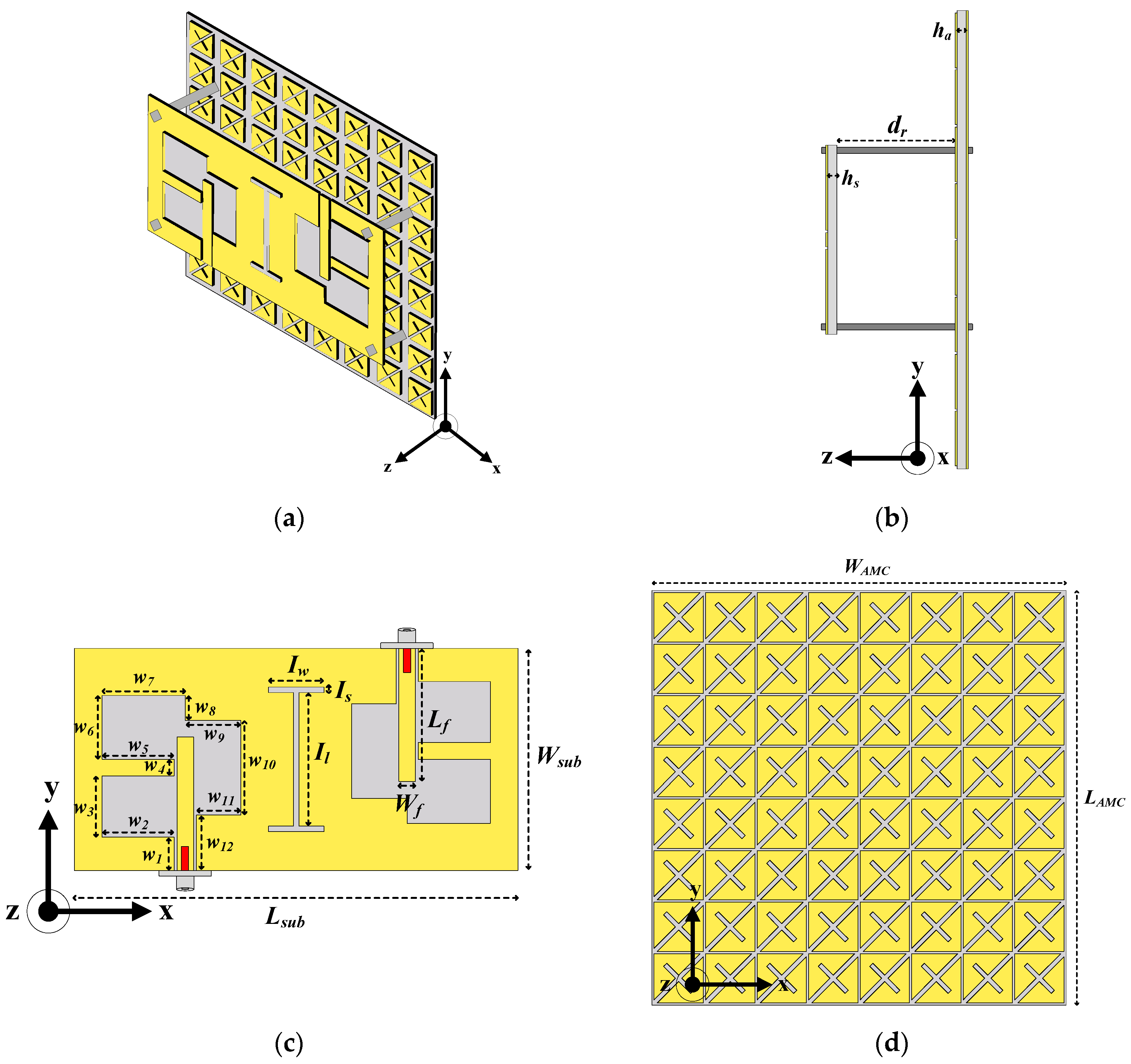

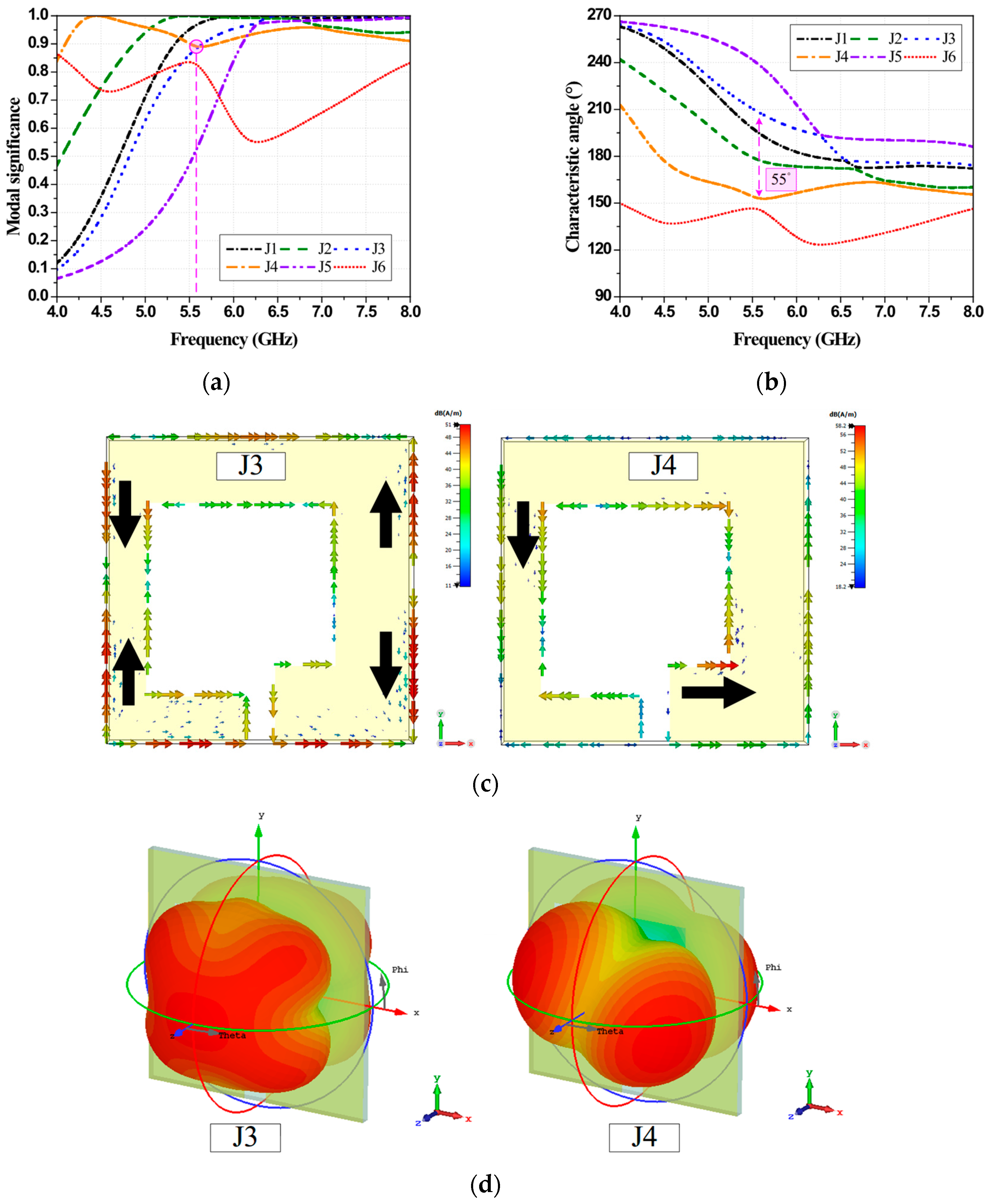

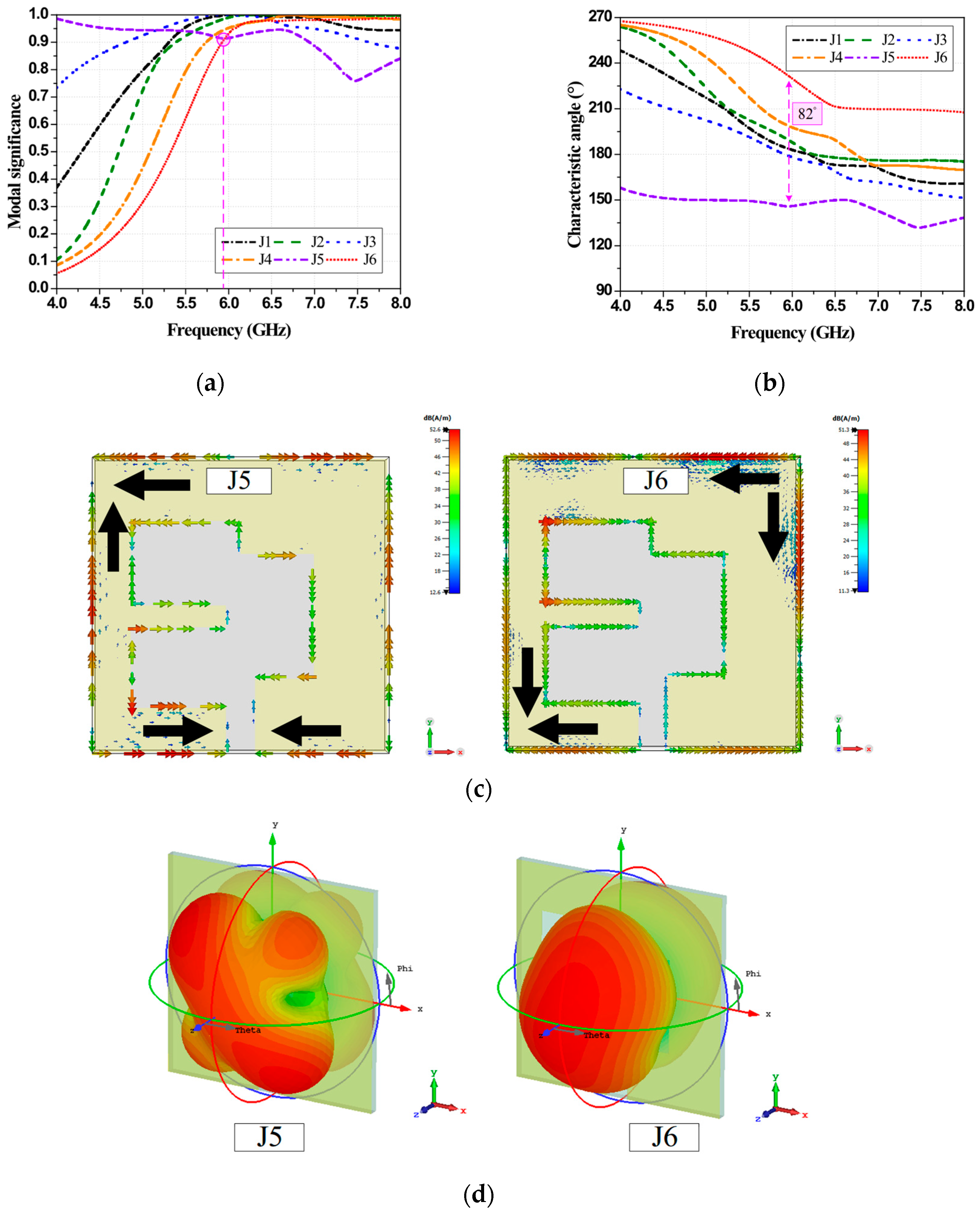

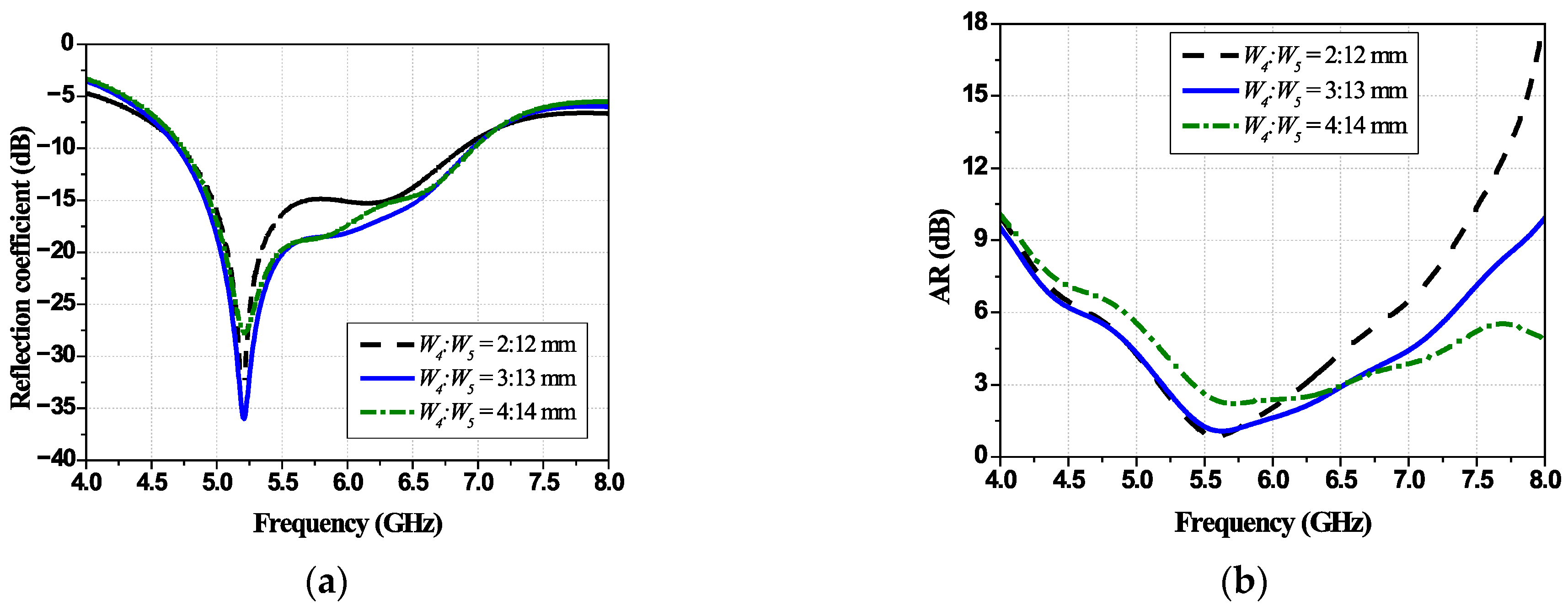
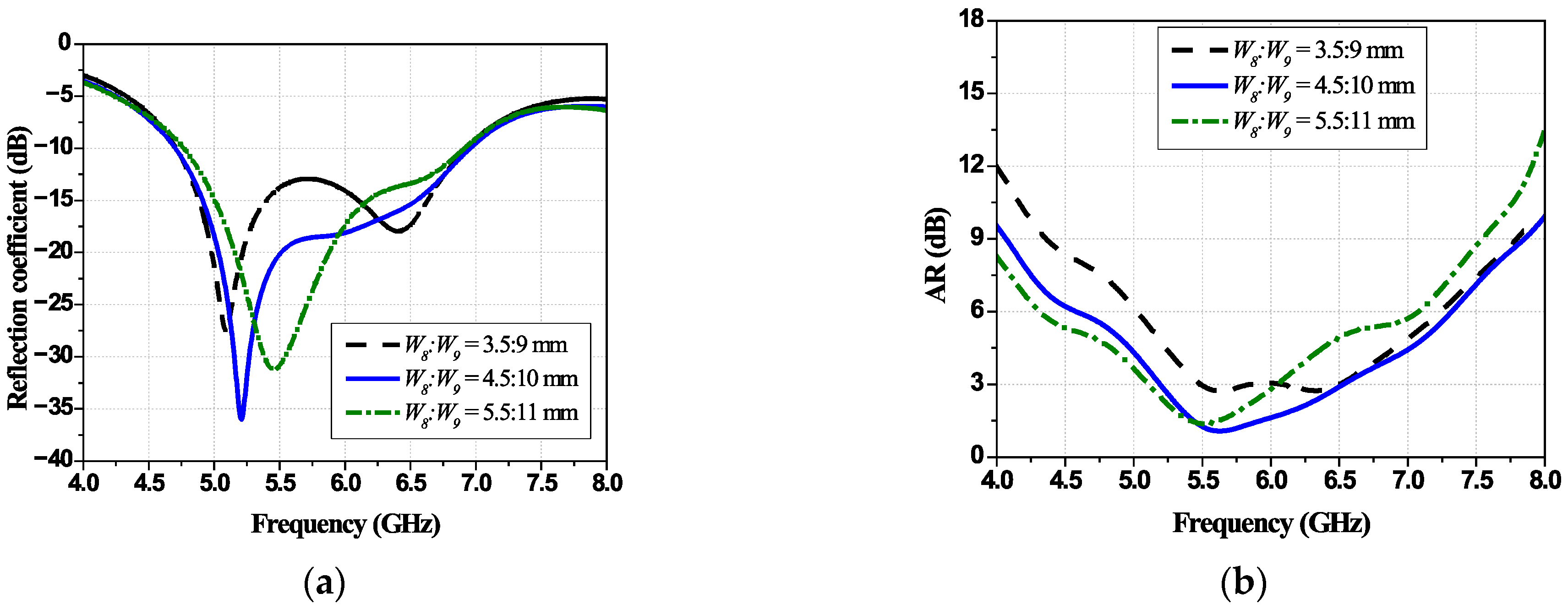
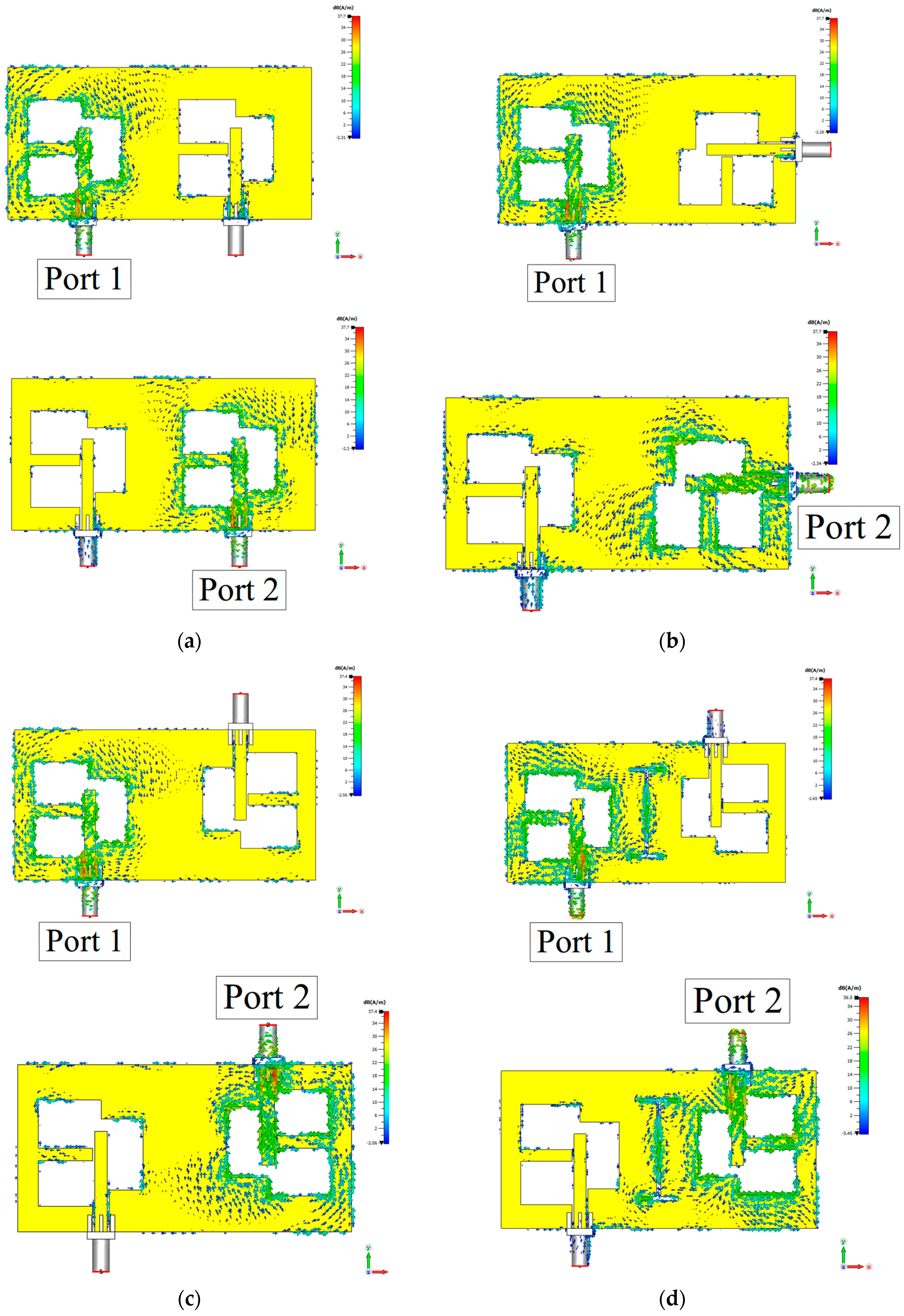


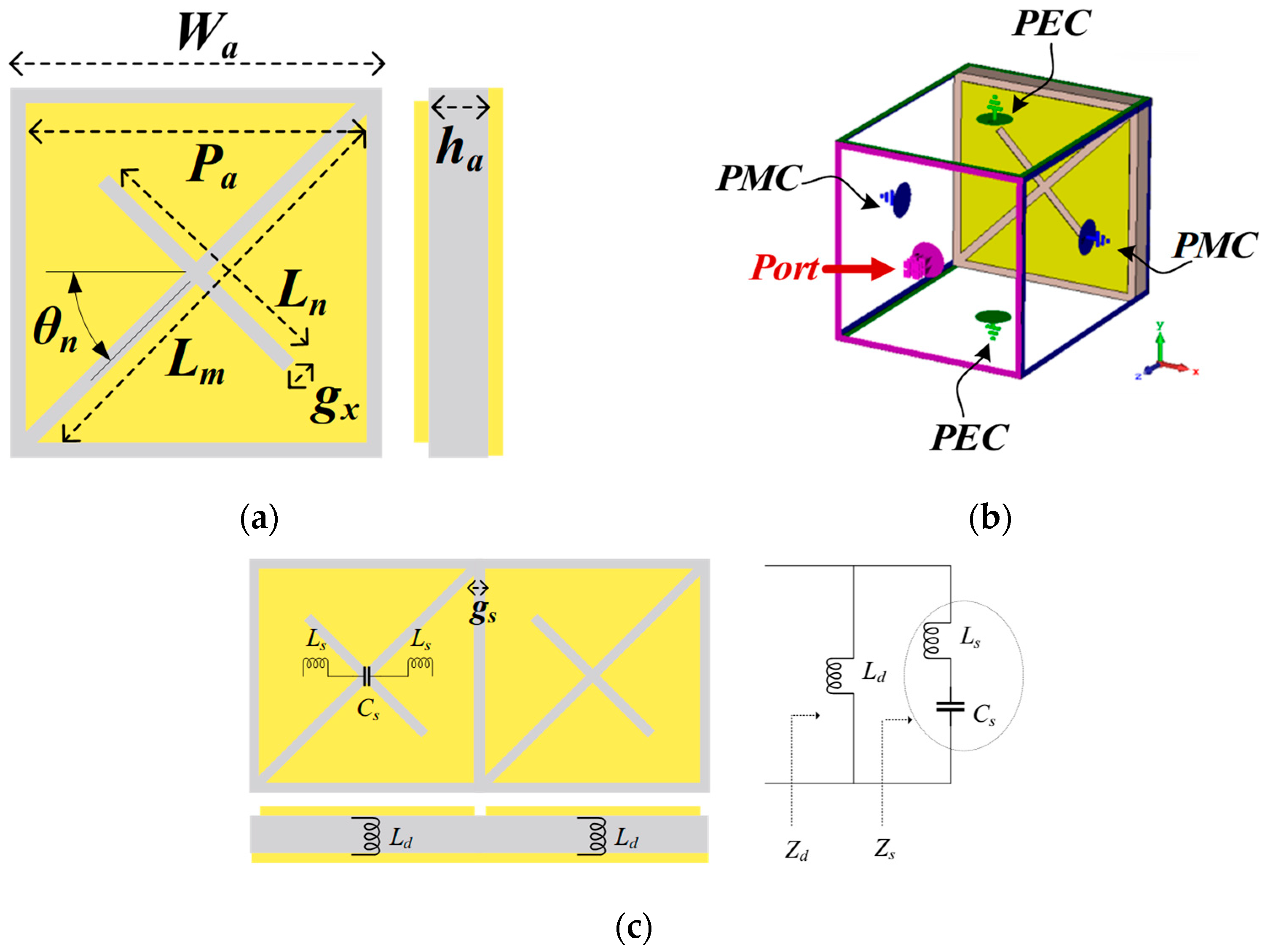


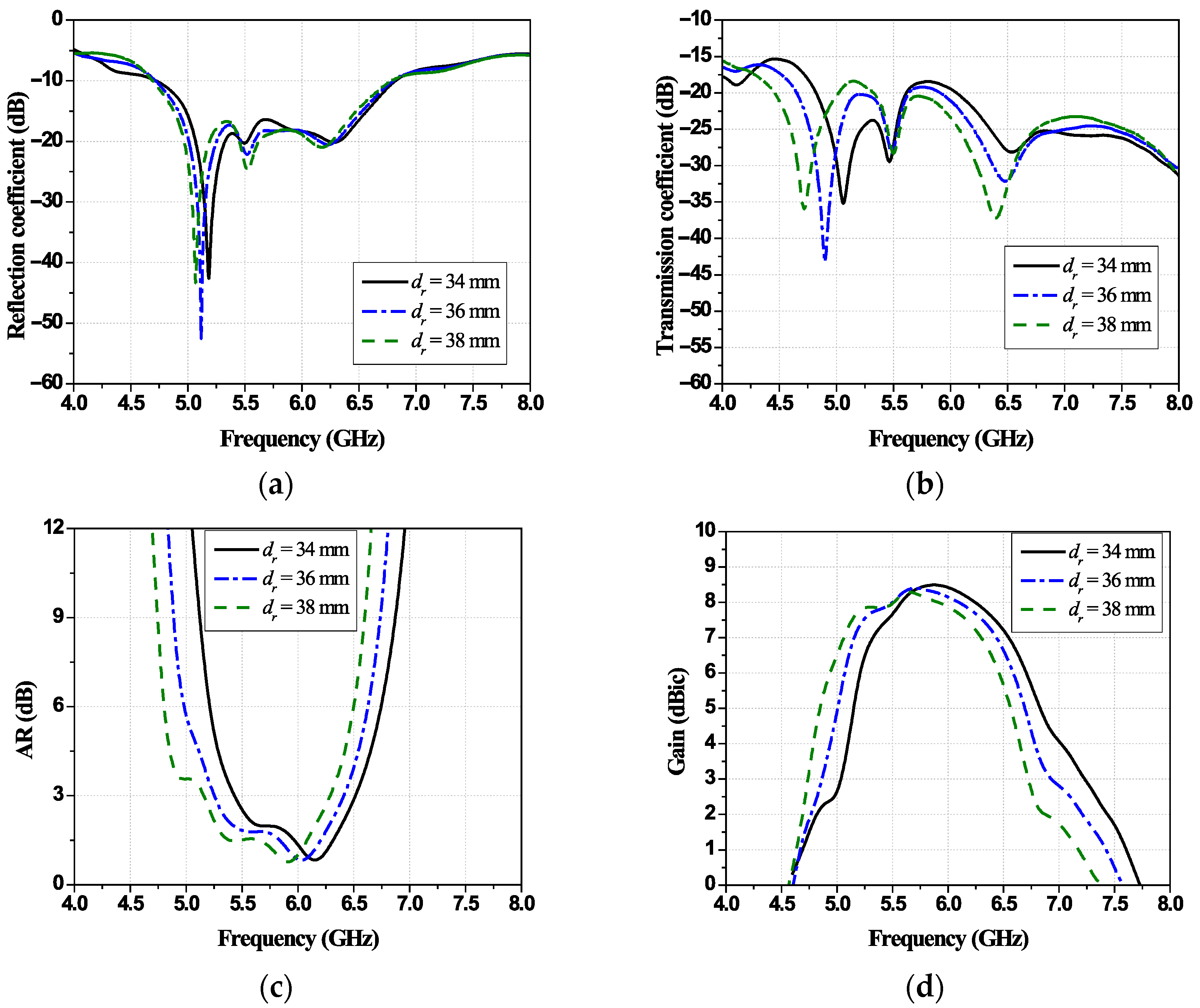
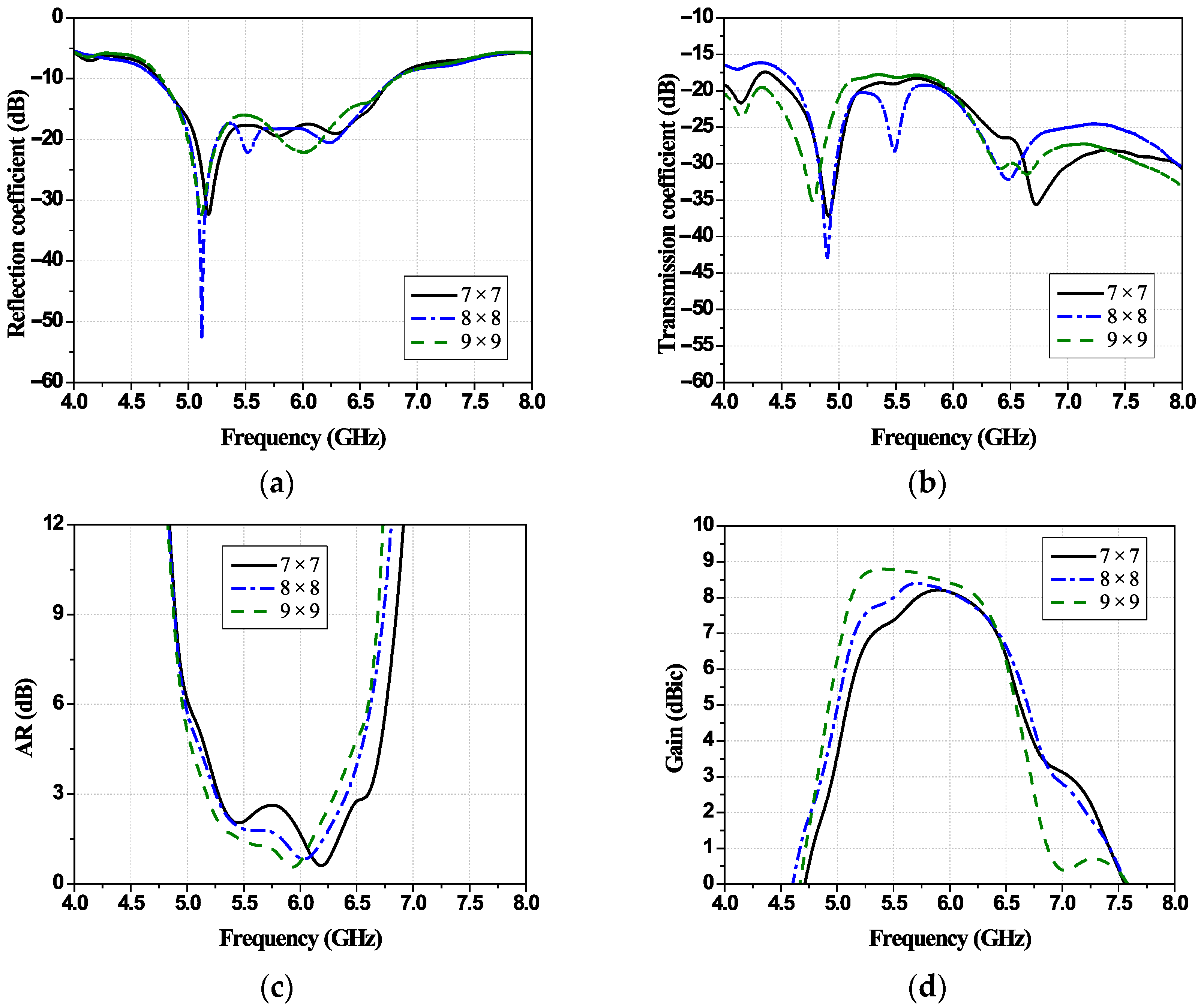
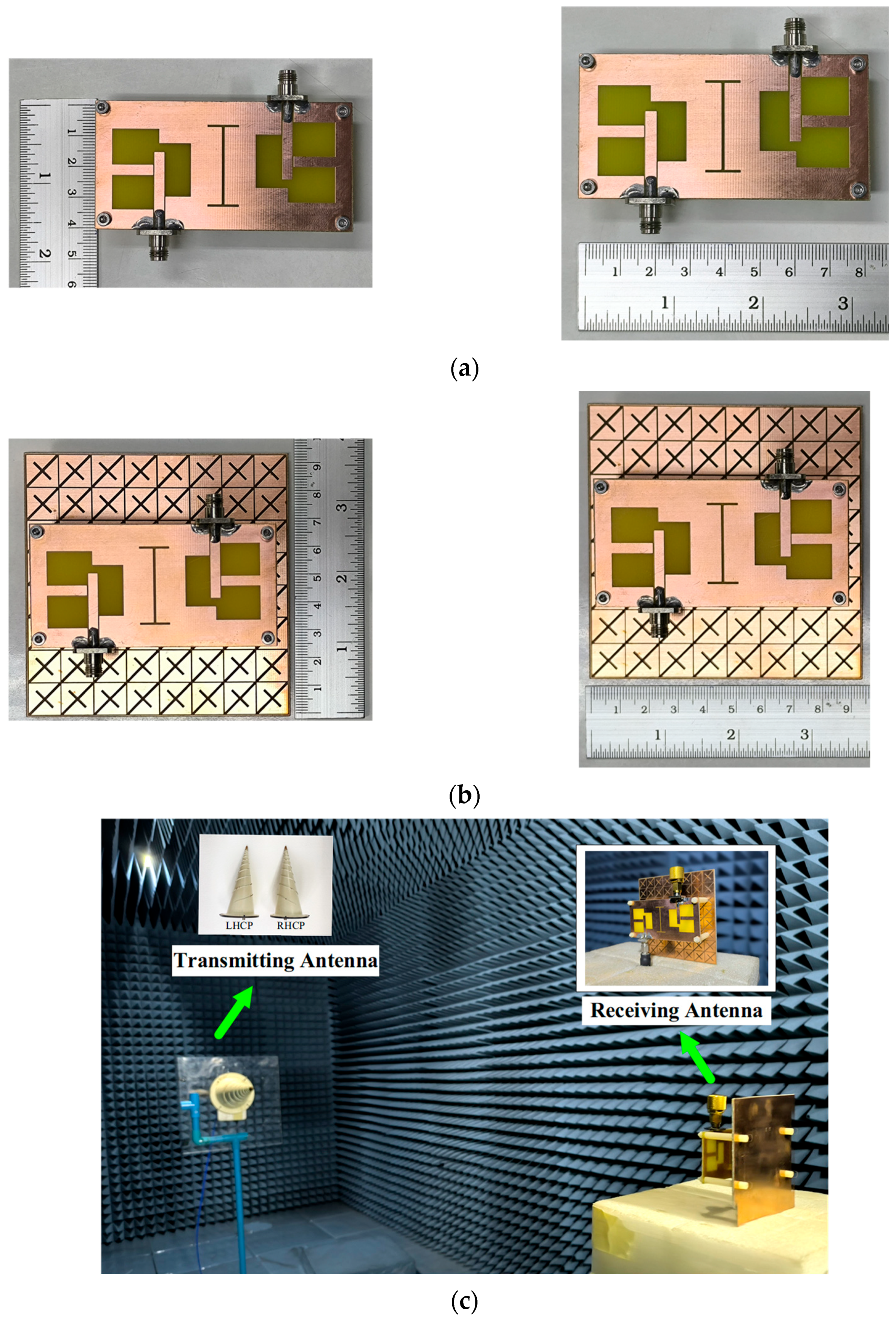


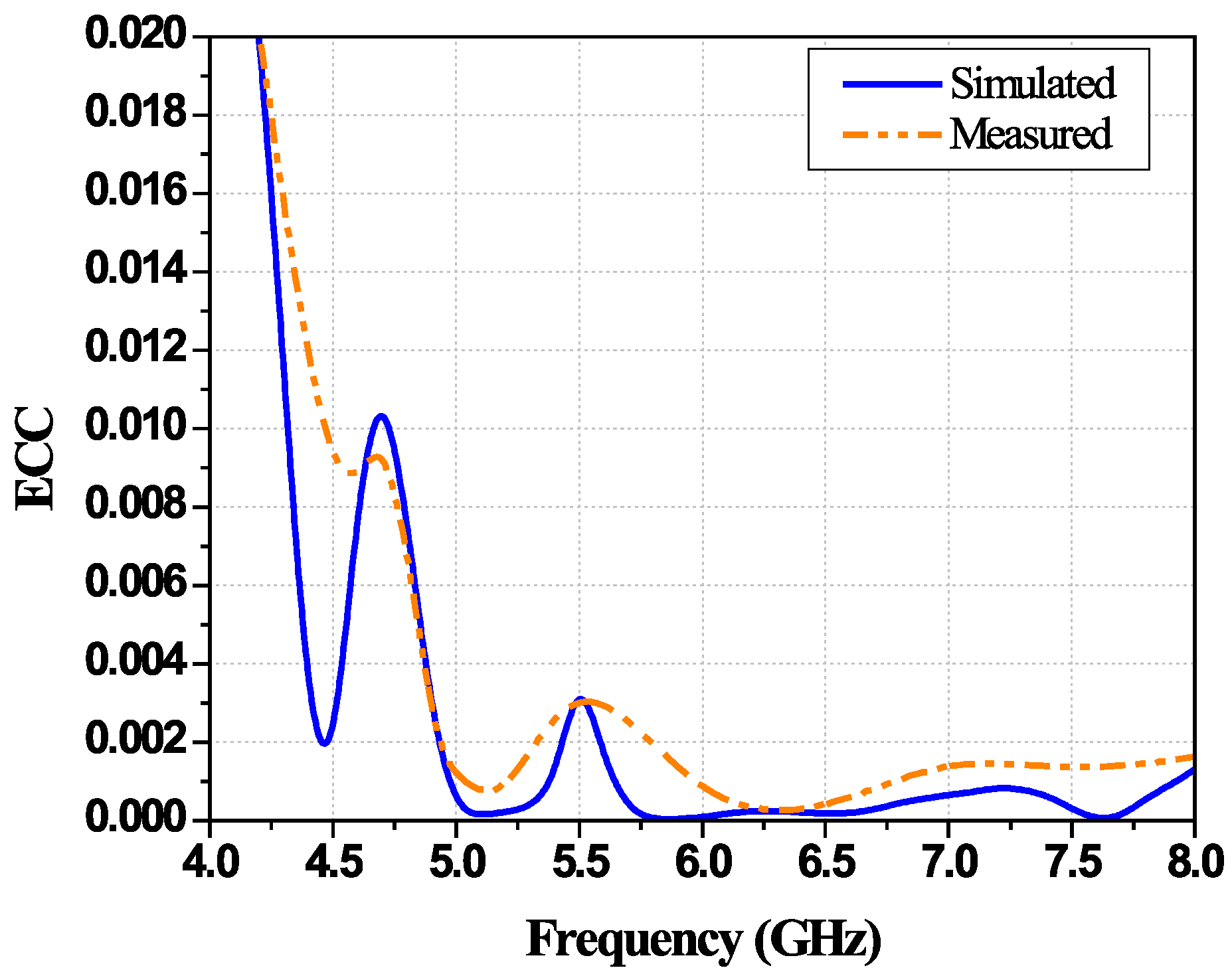
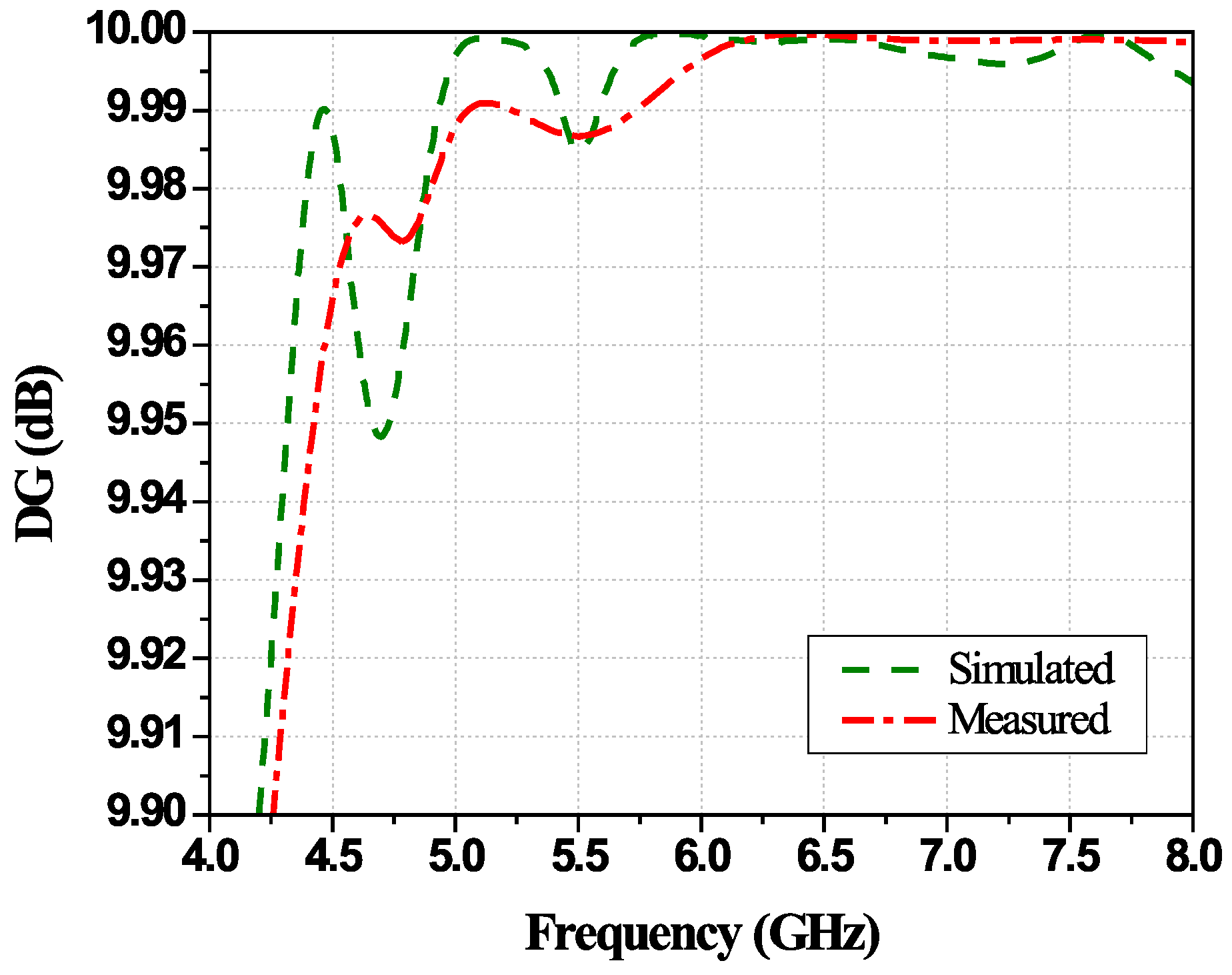
| Parameters | Lsub | Wsub | WAMC | LAMC | W1 | W2 | W3 |
| Values (mm) | 80 | 40 | 92.5 | 92.5 | 6 | 13 | 11 |
| Parameters | W4 | W5 | W6 | W7 | W8 | W9 | W10 |
| Values (mm) | 3 | 13 | 11.5 | 15 | 4.5 | 10 | 17 |
| Parameters | W11 | W12 | Iw | Is | Il | Wf | Lf |
| Values (mm) | 8 | 10 | 10 | 1 | 24 | 3 | 24 |
| Parameters | Wa | Pa | Ln | Lm | θn | gx | gs |
| Values (mm) | 12 | 11 | 5.5 | 15.06 | 45° | 0.5 | 0.5 |
| Parameters | ha | hs | dr | ||||
| Values (mm) | 1.6 | 1.6 | 36 |
| Layouts | Geometry Change | CMA Results | RLBW (GHz) | ARRW (GHz) | Max. Gain (dBic) | |||
|---|---|---|---|---|---|---|---|---|
| MS | Phase Diff. of CA | Current Distribution | Radiation Pattern | |||||
| First | Square copper plate (PEC) with asymmetric square slot | Modes J3 and J4 with 0.88 at 5.6 GHz | 55° | Non-orthogonal direction | Non-symmetrical main lobe | 4.93–6.68 | 5.56–5.74 | 2.46 at 5.3 GHz |
| Second | Rectangular stub at the right corner of the slot ground plane | Modes J3 and J6 with 0.91 at 6.1 GHz | 67° | Non-orthogonal direction | Modes J3 with null-radiation at the main lobe | 4.63–6.77 | 5.81–6.76 | 1.38 at 6 GHz |
| Third | Strip-line stub at the center-left of the slot ground plane | Modes J5 and J6 with 0.92 at 5.9 GHz | 82° | Orthogonal direction | CP radiation | 4.7–6.95 | 5.19–6.53 | 3.51 at 5.6 GHz |
| Ref. | Antenna Type | Operating Frequency (GHz) | Center Frequency (GHz) | |S11| (%) | Isolation (dB) | ARBW (%) | Max. Gain (dBic) | ECC | Fabrication Complexity | Cost/Installation | Overall Physical Size (mm3) | Overall Electrical Size (λ3) |
|---|---|---|---|---|---|---|---|---|---|---|---|---|
| [14] | Slot-integrated MIMO antenna with PEC reflector | 2.9–7.1 | 3 | 82 | >22 | 68.5 | 6 | <0.003 | Low | High (Rogers RO4003) | 99.73 × 33.50 × 21.40 | 1.78 × 0.59 × 0.55 |
| [36] | Slot-integrated MIMO antenna with circular-slot square FSS | 3–6 | 3.5 | 85.71 | >13 | N/A | 7.96 | <0.004 | Low | Low (FR-4) | 221.00 × 179.00 × 56.00 | 2.21 × 1.79 × 0.56 |
| [37] | Slot-integrated MIMO antenna with coplanar ground and PEC reflector | 4.5–6.7 | 4.5 | 39.3 | >15 | 39.3 | 5.8 | <0.005 | Low | High (Rogers 4350B) | 117.50 × 94.90 × 30.00 | 1.62 × 1.14 × 0.47 |
| [38] | CPW-fed MIMO antenna with PEC reflector | 5.2–6.3 | 5.2 | 18.3 | >22 | 18.3 | 5.8 | <0.004 | Low | High (Rogers RO4003) | 99.70 × 33.50 × 0.81 | 1.16 × 0.43 × 0.44 |
| [39] | Microstrip-line feeding MIMO antenna with DGS and metasurface reflector | 2.36–2.5 3.43–3.5 5.15–5.88 | 2.46 3.51 5.31 | 5.76 2.02 13.22 | >17 >18 >32 | N/A | 5.49 4.57 0.8 | <0.03 <0.035 <0.005 | Low | Low (FR-4) | 52.00 × 36.70 × 1.50 | 1.37 × 1.37 × 0.21 |
| This work | Slot-integrated MIMO antenna with X-notch square AMC | 4.72–6.61 | 5.9 | 32 | >19 | 21.18 | 8.6 | <0.003 | Low | Low (FR-4) | 92.50 × 92.50 × 39.20 | 2.87 × 2.87 × 1.17 |
Disclaimer/Publisher’s Note: The statements, opinions and data contained in all publications are solely those of the individual author(s) and contributor(s) and not of MDPI and/or the editor(s). MDPI and/or the editor(s) disclaim responsibility for any injury to people or property resulting from any ideas, methods, instructions or products referred to in the content. |
© 2025 by the authors. Licensee MDPI, Basel, Switzerland. This article is an open access article distributed under the terms and conditions of the Creative Commons Attribution (CC BY) license (https://creativecommons.org/licenses/by/4.0/).
Share and Cite
Musika, C.; Supreeyatitikul, N.; Konpang, J.; Chomtong, P.; Akkaraekthalin, P. Dual-Element Wideband CP Slot-Integrated MIMO Antenna with X-Notch Square AMC for DSRC Applications. Technologies 2025, 13, 367. https://doi.org/10.3390/technologies13080367
Musika C, Supreeyatitikul N, Konpang J, Chomtong P, Akkaraekthalin P. Dual-Element Wideband CP Slot-Integrated MIMO Antenna with X-Notch Square AMC for DSRC Applications. Technologies. 2025; 13(8):367. https://doi.org/10.3390/technologies13080367
Chicago/Turabian StyleMusika, Chanwit, Nathapat Supreeyatitikul, Jessada Konpang, Pongsathorn Chomtong, and Prayoot Akkaraekthalin. 2025. "Dual-Element Wideband CP Slot-Integrated MIMO Antenna with X-Notch Square AMC for DSRC Applications" Technologies 13, no. 8: 367. https://doi.org/10.3390/technologies13080367
APA StyleMusika, C., Supreeyatitikul, N., Konpang, J., Chomtong, P., & Akkaraekthalin, P. (2025). Dual-Element Wideband CP Slot-Integrated MIMO Antenna with X-Notch Square AMC for DSRC Applications. Technologies, 13(8), 367. https://doi.org/10.3390/technologies13080367





